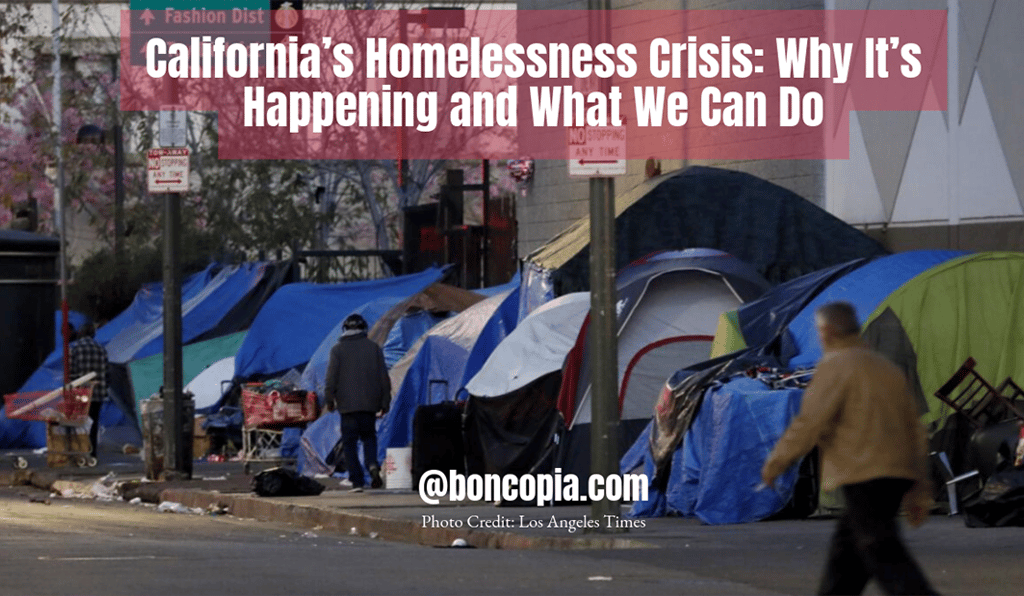California’s Homelessness Crisis: Why It’s Happening and What We Can Do
5/4/20254 min read


California’s Homelessness Crisis: Why It’s Happening and What We Can Do
Published on Boncobia.com
Date: May 3, 2025
The Harsh Reality on California’s Streets
California is known for its golden sun, diverse communities, and laid-back vibe, but a darker truth lurks beneath the surface. As of January 2024, 187,084 people were experiencing homelessness in the state—0.48% of its population, the highest per capita rate in the U.S. (en.wikipedia.org, 2025). A recent X post by Benny Johnson (@bennyjohnson, May 1, 2025) painted a grim picture of downtown L.A., showing tents, trash, and people living in dire conditions, which he called “3rd world.” Why is homelessness so rampant in California, where do these individuals come from, and what’s being done? Let’s break it down.
What’s Driving Homelessness in California?
Housing Costs Out of Control
The biggest culprit is California’s housing crisis. Skyrocketing rents and a severe shortage of affordable homes have pushed many to the brink. Between 2010 and 2020, while the national homeless population dropped by 18%, California’s surged by 31% (en.wikipedia.org, 2025). The Stanford Institute for Economic Policy Research notes that streamlining housing production and easing regulations could help, but progress is slow (siepr.stanford.edu). In cities like L.A. and San Francisco, long waiting lists for affordable units leave many with nowhere to go.
Mental Health and Addiction Struggles
A significant portion of California’s chronically homeless population battles mental health issues and drug addiction. The same Stanford report highlights that intensive care is crucial for these individuals, yet access to treatment is limited by long wait times, lack of transportation, and bureaucratic hurdles. Recent policy changes have also reduced pathways to drug treatment, leaving many stuck in a cycle of addiction and homelessness.
The Weather Factor
California’s mild climate plays a role, too. Two-thirds of the state’s homeless population is unsheltered—the highest rate in the U.S.—living on streets, in encampments, or in cars (en.wikipedia.org, 2025). The weather draws people from across the country, as it’s easier to survive outdoors year-round compared to colder states. This has made California a hotspot for homelessness, with 45% of the nation’s unsheltered homeless residing here.
Where Are They Coming From?
Many assume California’s homeless population is mostly out-of-state migrants, but that’s not the full picture. A 2023 UCLA study found that 75% of the state’s homeless were already living in California before losing their homes (calbudgetcenter.org, 2024). These are locals displaced by rising costs, job loss, or personal crises like medical emergencies. The other 25% come from elsewhere, often lured by the weather and the state’s reputation for progressive policies, but they face the same housing struggles once they arrive.
How Do They End Up Homeless?
For many, homelessness starts with a single blow: a rent hike, a medical bill, or a layoff. X user@rascal113646 shared paying $22,000 in annual property taxes yet still feeling the squeeze, a sentiment echoing the financial strain many face. Systemic issues worsen the problem—underfunded housing programs, stagnant wages, and a lack of mental health support create a perfect storm. The aging homeless population, with nearly 40% over 50, often can’t keep up with inflation on fixed incomes (calbudgetcenter.org, 2024).
What’s the Government Doing?
Governor Gavin Newsom has taken steps to address the crisis. The Homekey program, for instance, allocated $179.7 million in 2024 to create 710 homes across seven counties, contributing to 13,484 total units (www.gov.ca.gov, 2024). Plans are also underway to build 1,200 small homes for homeless individuals by the end of 2024. During the pandemic, California pioneered non-congregate shelters, a model that proved effective for protecting vulnerable people.
But these efforts aren’t enough. The homeless population grew by 5,000 from 2023 to 2024, despite the state spending $20 billion over five years (calmatters.org, 2024). X users like @GuntherEagleman and
@MeezmoApril blame Newsom and Mayor Karen Bass, pointing to persistent encampments and public health risks like tuberculosis outbreaks in shelters (en.wikipedia.org, 2025). Many unsheltered individuals avoid shelters due to safety concerns, strict rules, or a desire for autonomy, preferring the streets despite the dangers.
Why Isn’t There More Help?
The crisis outpaces resources. More than 270,000 homeless individuals received services in 2021, but the system can’t keep up. Inefficiency and alleged corruption, as noted by X users, drain funds, while bureaucratic delays stall housing projects. Building more shelters and expanding mental health services are critical, but political and public support often waver.
How to Prepare and Avoid Homelessness
If you’re worried about economic instability, here’s how to protect yourself:
Save Aggressively: Aim for a three-month expense buffer to handle unexpected setbacks.
Tap Into Resources: Research local programs like California’s CalWORKs for emergency aid.
Build a Support Network: Lean on family, friends, or community groups for help in tough times.
Diversify Income: Explore side gigs or new skills to boost financial resilience.
Prioritize Mental Health: Seek support early through programs like Medi-Cal, even if access is tough.
Looking Ahead
California’s homelessness crisis demands bold action—more affordable housing, better mental health care, and increased shelter capacity. As a community, we can advocate for change, support nonprofits, and show compassion.
What do you think: Should the state focus on housing or social services first? Have you seen homelessness impact your community, and what solutions resonate with you? Let’s start the conversation.
Photo Credit: GettyImage
hello@boncopia.com
+13286036419
© 2025. All rights reserved.